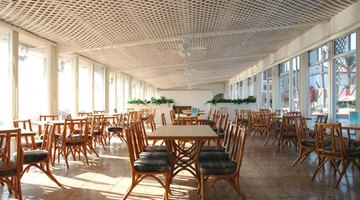How to Upholster a Dining Room Chair Seat With Piping
A dining room chair with piping along the edges is more difficult to reupholster than a chair with a plain cushion. Dinning room chairs can have piping around the top, around the bottom or around both.

A cushion with piping around the top edge is constructed by sewing a shaped cushion cover which is pulled over a foam cushion form. This type of chair will sometimes have sewn on piping around the bottom of the cushion.
Tip
Piping around the bottom edge of a plain cushion is usually stapled on after the cushion is covered. Single piping is added before the cushion is screwed to the chair. Double piping is stapled on after the cushion is reattached.
Making the Piping
-
Measure around the piping on the chair to determine the length of piping you will need. Make two extra inches for overlap. Wrap a measuring tape around the piping cord to determine the width of the bias strip you will need to cover the cord. Add a 1/2-inch seam allowance on each side of the bias strip.
-
Fold the fabric at a 90-degree angle. Cut the bias strips along this fold.
-
Wrap the bias strips around the piping cord with the right side of the fabric out. Align the edges of the strip and use a zipper foot to sew very close to the cord. The closer you sew to the cord the better your piping will look.
Sewing the Cushion Cover
-
Unscrew the cushion from the chair. Remove the staples holding the fabric to the cushion form. Remove the fabric. It should come off in one piece.
-
Place the cushion form top side down on a large sheet of paper. Trace around the cushion. Add a 1/2-inch seam allowance all around. Use this pattern to cut out the top of your cushion cover.
-
Measure the side of the cushion. Add 1 inch to this measurement if your cushion will have piping along the bottom. If your cushion will not have piping around the bottom, add 3 inches. Measure around the cushion. Add 3 inches to this measurement for seam allowances and ease. Cut a strip of fabric with these measurements for the sides of your cushion cover.
-
Baste the piping along the edges of the cushion top, using a 1/2-inch seam allowance. Align the edges of the piping with the edges of the cushion top. The piping should be on the right side of the fabric with the corded edge toward the center.
-
Leave an extra inch of piping at the end of the seam. Open the last inch of piping and cut off 1 inch of the cording inside. Fold the end of the fabric under 1/2 inch, and wrap the fabric around the opposite end of the piping to create a finished edge. Baste this overlap in place.
-
Pin the sides of the cushion to the top of the cushion with the right sides together. Align the top edge of the side piece with the edge of the fabric and piping. Start this seam in the middle of the back, 1/2 inch from the end of the fabric strip. Sew the seam with a 1/2-inch seam allowance. Clip the curves.
-
Sew the ends of the side piece together, wherever they meet, with a 1/2-inch seam allowance. Cut off any excess fabric. If your cushion will have sew-on piping along the bottom edge sew it on in the same way you attached to top piping. Turn the cushion cover right side out.
-
Pull the new cover over the cushion form. Pull the edges down tightly and staple them to the underside of the cushion form. Ease in the fullness on the corners. Screw the cushion back on the chair.
The Drip Cap
- A dining room chair with piping along the edges is more difficult to reupholster than a chair with a plain cushion.
- Measure around the piping on the chair to determine the length of piping you will need.
- Make two extra inches for overlap.
- Measure the side of the cushion.
- Add 1 inch to this measurement if your cushion will have piping along the bottom.
- Baste this overlap in place.
- Align the top edge of the side piece with the edge of the fabric and piping.
- Sew the ends of the side piece together, wherever they meet, with a 1/2-inch seam allowance.
- Pull the new cover over the cushion form.
References
Writer Bio
Camela Bryan's first published article appeared in "Welcome Home" magazine in 1993. She wrote and published SAT preparation worksheets and is also a professional seamstress who has worked for a children's theater as a costume designer and in her own heirloom-sewing business. Bryan has a Bachelor of Science in chemical engineering from the University of Florida.
Photo Credits
- dining hall image by Karin Lau from Fotolia.com
- dining hall image by Karin Lau from Fotolia.com
More Articles



